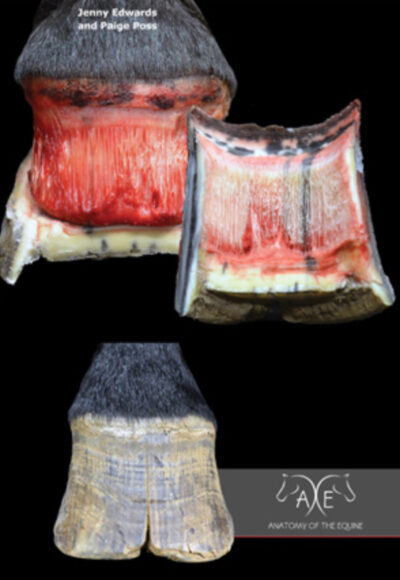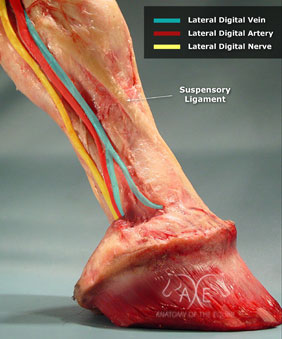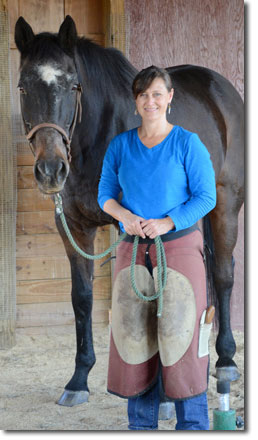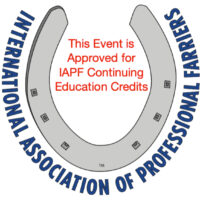single learning post
Paige Poss Explores Hoof Distortions and Hoof Related Pain
This two part webinar series is a detailed exploration of the hoof and its connection to internal structures and nerve pathways.
Part 1 – Hoof Distortions Unveiled: Exploring the Connection Between Hoof Capsule Changes and Internal Tissues
In this enlightening lecture, Paige will delve into the intricate relationship between hoof distortions and the internal tissues that play a crucial role in equine foot growth and health. She will unravel the spatial relevance, texture, and function of the internal structures within the hoof capsule, shedding light on the profound impact hoof distortions can have on these vital components. Comparative anatomy images will be utilized to illustrate the diverse changes that occur within the hoof. Gain valuable insights into how an in-depth understanding of these internal dynamics enhances our ability to comprehend and address hoof capsule distortions effectively. Whether you’re a seasoned hoof care provider, veterinarian, or horse enthusiast, this lecture promises to deepen your knowledge and refine your approach to maintaining optimal equine hoof health.

Part 2 – Navigating Hoof Pain: Tracing the Palmar Digital Nerve’s Path within the Hoof
Embark on a detailed exploration of the palmar digital nerve’s intricate journey into the hoof capsule. This lecture, supported by comparative anatomy images, meticulously documents the nerve’s precise path, offering valuable insights into its placement and its potential impact on equine lameness. Discover how the nerve’s specific placement can lead to adverse reactions in horses, affecting their response to various appliances added to the hoof, and subsequently influencing the work of equine professionals. Gain a deeper understanding of the palmar digital nerve’s pivotal role in hoof health, equipping hoof care providers, veterinarians, and horse enthusiasts with targeted insights to optimize both hoof function and the overall comfort of the horses under their care.

 Paige Poss has dedicated over 25 years to the hoof care industry, where she specializes in trimming horse hooves, conduction distal limb anatomy studies, and creating educational materials. Holding a BS degree in Animal Science from North Carolina State University, Paige initially ventured into the field as a lab tech at various research facilities. However, her journey took a turn in 1999 when a lame horse ignited her passion for hoof care. In collaboration with her business partner, Jenny Edwards, Paige co-founded Anatomy of the Equine, LLC, a platform that publishes and sells education materials tailored for farriers and veterinary professionals. Paige’s unique approach blends her love for photography, science, anatomy and art. Her fascination with hoof and horse anatomy has led her to dissect and photographically document hundreds of lower legs and even whole horses.
Paige Poss has dedicated over 25 years to the hoof care industry, where she specializes in trimming horse hooves, conduction distal limb anatomy studies, and creating educational materials. Holding a BS degree in Animal Science from North Carolina State University, Paige initially ventured into the field as a lab tech at various research facilities. However, her journey took a turn in 1999 when a lame horse ignited her passion for hoof care. In collaboration with her business partner, Jenny Edwards, Paige co-founded Anatomy of the Equine, LLC, a platform that publishes and sells education materials tailored for farriers and veterinary professionals. Paige’s unique approach blends her love for photography, science, anatomy and art. Her fascination with hoof and horse anatomy has led her to dissect and photographically document hundreds of lower legs and even whole horses.
Her most impactful dissection images, to date, focus on the palmar digital nerve as it descends deep into the hoof capsule. In 2020, Paige stepped back into the academic field and was asked to set up and manage the anatomy lab at the new University of Arizona College of Veterinary Medicine. She worked in this lab from 2020-2022 before returning to trimming and lecturing independently. As of 2024, Paige has delved into researching Equine Metabolic Syndrome as a lab tech at the University of Arizona. Paige’s unwavering commitment to understanding hoof mechanics, coupled with her technical skills, positions her as a trailblazer in the industry. Her dissections and clinics provide a creative and encouraging platform for others to explore hoof mechanics. Through her passion for teaching, Paige creates powerful images that not only educate but also inspire a deeper appreciation for the intricate world of horse anatomy. Paige continues to actively participate in clinics and speaking engagements, sharing her wealth of knowledge and experience. Currently residing in the Sonoran Desert in Tucson, AZ, Paige shares her home with her husband, cats, dog and horses.
This event is approved for 3 CE credits with the IAPF.

Type Online
With Paige Poss
Cost $100, $175 non-member
Credits 6
/ Status Currently unscheduled.
All clinics
- PHCP 2024 conference
- Wear Patterns, What They Really Mean!
- Feeding for Special Needs
- Feeding Pregnant and Growing Horses
- Beginning Clinic in California
- Beginning Clinic in Quebec
- Advanced Anatomy
- Beginning Clinic in Tennessee
- Feeding Performance Horses
- Beginning Clinic in Florida
- The Smart Way to Feed Horses
- EMS (IR) and PPID: Diagnosis and Management
- Reading Radiographs for the Hoof Care Practitioner
- Dr. Tomas Teskey on the Equine Dental-Body Connection
- Starting Your Hoof Care Business
- Choosing and Fitting Hoof Boots
- Beginning Clinic in Colorado
- Hands-on Radiographs for the Hoof Care Practitioner
- Beginning Clinic in New York
- Equine Biosecurity; It’s All About Prevention
- Essential Oils for Horses
- WTF? What the Founder
- Sustaining Your Hoof Care Business
- Donkey Behavior and Handling
- Utilizing Hoof Imaging in your Trimming Decisions
- Dr. Bowker on the Vasculature of the Equine Hoof
- Creating a Track System for Thriving Equines and Sustainable Management
- Introduction to Flex Boots™
- Genetics of Equine Metabolic Syndrome and Laminitis Risk
- Trimming Foals
- NRC Plus
- Basics of Reading Radiographs
- Cushing’s and Insulin Resistance
All of our educational offerings are open to the public.
An educational foundation for hoof care professionals and horse owners.
©2024 Progressive Hoof Care Practitioners / Privacy / Terms & Conditions / Website vizou

